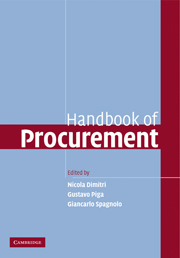Book contents
- Frontmatter
- Contents
- List of figures
- List of tables
- List of contributors
- Preface
- Part I Preliminary Issues
- Part II General Strategic Principles
- Part III Competitive Tendering Strategies
- 6 Information and competitive tendering
- 7 Division into lots and competition in procurement
- 8 Multi-contract tendering procedures and package bidding in procurement
- 9 Dynamic auctions in procurement
- Part IV Attracting and Screening Participants
- Part V Preventing Collusion and Corruption
- Part VI Dynamic Forces and Innovation
- Glossary
- Index
- References
6 - Information and competitive tendering
Published online by Cambridge University Press: 04 November 2009
- Frontmatter
- Contents
- List of figures
- List of tables
- List of contributors
- Preface
- Part I Preliminary Issues
- Part II General Strategic Principles
- Part III Competitive Tendering Strategies
- 6 Information and competitive tendering
- 7 Division into lots and competition in procurement
- 8 Multi-contract tendering procedures and package bidding in procurement
- 9 Dynamic auctions in procurement
- Part IV Attracting and Screening Participants
- Part V Preventing Collusion and Corruption
- Part VI Dynamic Forces and Innovation
- Glossary
- Index
- References
Summary
Introduction
As stressed in the previous chapter by Bajari and Tadelis, it would be optimal for a procurer wishing to buy a sufficiently standardized, and contractually well-specifiable, good or service to elicit competition among potential suppliers. There are, however, many mechanisms she could use to elicit such competition. This chapter discusses and provides practical indications on how to choose between a sealed bid tendering and a dynamic auction to allocate procurement contracts between competing suppliers. It then suggests simple strategies to keep under control the duration of dynamic procurement auctions when this is a concern for the procurer.
A crucial factor to consider in the optimal choice of a tendering format is the nature of uncertainty and the size of different types of costs the selected supplier will face when serving the contract. Therefore we begin with an example of such uncertain costs.
Consider a procurement for cleaning services of a large company's or public administration's buildings. The contract may specify a variety of services including the cleaning of offices, corridors, halls and more demanding tasks such as the sanitation of laboratories. The contract also establishes that the contractor(s) will be paid a fixed amount of money per unit of surface (€/m2) regardless of the nature of the building. Therefore the unit price coincides across categories of surface, whereas the cost of performing the same task in different environments may vary substantially.
- Type
- Chapter
- Information
- Handbook of Procurement , pp. 143 - 167Publisher: Cambridge University PressPrint publication year: 2006
References
- 1
- Cited by



